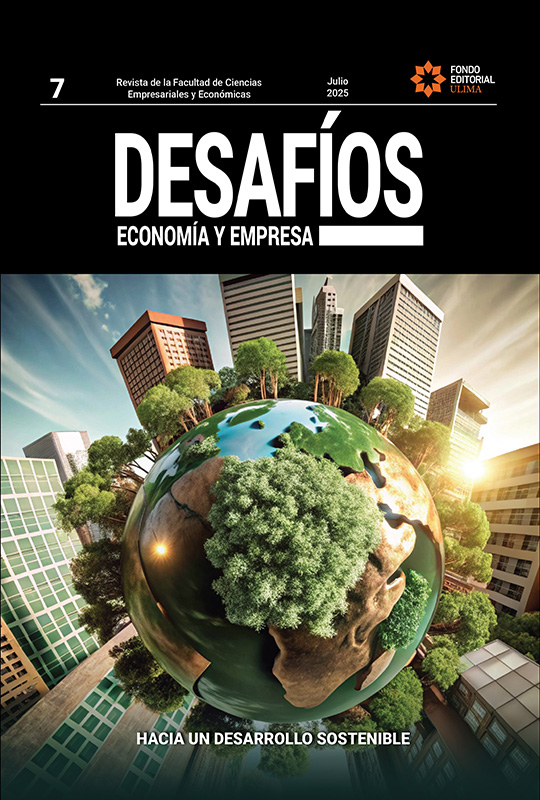Peru: Stable despite everything
DOI:
https://doi.org/10.26439/ddee2025.n007.6885Keywords:
Peru, development, stability, dirty float, central bank independenceAbstract
This research article seeks to answer a crucial question in collective mindset: Why does the Peruvian economy maintain steady growth and not experience a significant downturn despite the ongoing social and political crises the country faces? The reasons outlined in this article are five fundamental pillars of the country’s stability: the independence of key institutions, the “dirty float” exchange rate regime, sound fiscal policy frameworks that ensure current accounts, the constant inflow of foreign exchange through the primary-export model, and finally, advances in diversification that reduce dependence on a single industry. Criticisms, proposals for improvement, and questions that may lead to future research are also addressed in this study.
Downloads
References
Alesina, A., & Summers, L. H. (1993). Central bank independence and macroeconomic performance: some comparative evidence. Journal of Money, Credit and Banking, 25(2), 151-162. https://doi.org/10.2307/2077833
Anwar, S., & Nguyen, L. P. (2011). Foreign direct investment and export spillovers: evidence from Vietnam. International Business Review, 20(2), 177-193. https://doi.org/10.1016/j.ibusrev.2010.11.002
Anwar, S., & Nguyen, L. P. (2014). Is foreign direct investment productive? A case study of the regions of Vietnam. Journal of Business Research, 67(7), 1376-1387. https://doi.org/10.1016/j.jbusres.2013.08.015
Armas, A., Grippa, F., Quispe, Z., & Valdivia, L. (2001). De metas monetarias a metas de inflación en una economía con dolarización parcial: el caso peruano. Revista Estudios Económicos, 7. https://www.bcrp.gob.pe/docs/Publicaciones/Revista-Estudios-Economicos/07/Estudios-Economicos-7-2.pdf
Ascarza Mendoza, D. D. (2017). Precios de commodities, términos de intercambio y productividad en el Perú: un enfoque DSGE [Master’s Thesis, Universidad del Pacífico]. Repositorio Institucional de la Universidad del Pacífico. http://hdl.handle.net/11354/1884
Balding, C. (2012). Sovereign wealth funds: the new intersection of money and politics. Oxford University Press. https://doi.org/10.1093/acprof:oso/9780199842902.001.0001
Bazán Navarro, C. E., & Álvarez-Quiroz, V. J. (2022). Foreign direct investment and exports stimulate economic growth? Evidence of equilibrium relationship in Peru. Economies, 10(10), 234. https://doi.org/10.3390/economies10100234
Ben Hammouda, H., Karingi, S. N., Njuguna, A. E., & Sadni Jallab, M. (2010). Growth, productivity and diversification in Africa. Journal of Productivity Analysis, 33(2), 125-146. https://doi.org/10.1007/s11123-009-0155-5
Blinder, A. S. (1999). Central banking in theory and practice. MIT Press. https://archive.org/details/centralbankingin0000blin_n3s4
Castillo, P., Montoya, J., & Quineche, R. (2016). From the “Great inflation” to the “Great moderation” in Peru: A time varying structural vector autoregressions analysis (Working Paper No. 2016-003). Banco Central de Reserva del Perú. https://www.bcrp.gob.pe/docs/Publicaciones/Documentos-de-Trabajo/2016/documento-de-trabajo-03-2016.pdf
Castillo, P., Pérez, F., & Tuesta, V. (2011). Los mecanismos de transmisión de la política monetaria en Perú. Revista Estudios Económicos, 21, 41-63. https://www.bcrp.gob.pe/docs/Publicaciones/Revista-Estudios-Economicos/21/ree-21-castillo-perez-tuesta.pdf
Connolly, E., & Orsmond, D. (2011). The mining industry: From bust to boom [Research Discussion Paper No. 2011-08]. Reserve Bank of Australia. https://www.rba.gov.au/publications/rdp/2011/pdf/rdp2011-08.pdf
Contreras Carranza, C. (2021). Historia económica del Perú: desde la conquista española hasta el presente. Instituto de Estudios Peruanos.
Cukierman, A. (2003). Central bank strategy, credibility and independence: Theory and evidence. MIT Press.
De Echave, J., Diez, A., Huber, L., Revesz, B., Ricard Lanata, X., & Tanaka, M. (2009). Minería y conflicto social. Instituto de Estudios Peruanos. https://hdl.handle.net/20.500.14660/639
Foster, A., & Rosenzweig, M. (2004). Agricultural productivity growth, rural economic diversity, and economic reforms: India, 1970-2000. Economic Development and Cultural Change, 52(3), 509-542. http://dx.doi.org/10.1086/420968
Frieden, J. A. (2002). Real sources of European currency policy: Sectoral interests and European monetary integration. International Organization, 56(4), 831-860. https://doi.org/10.1162/002081802760403793
Fu, X., Emes, D., & Hou, J. (2021). Multinational enterprises and structural transformation in emerging and developing countries: a survey of the literature. International Business Review, 30(2), 1-11. https://doi.org/10.1016/j.ibusrev.2021.101801
Grilli, V., Masciandaro, D., & Tabellini, G. (1991). Political and monetary institutions and public financial policies in the industrial countries. Economic Policy, 6(13), 341-392. https://doi.org/10.2307/1344630
Instituto Nacional de Estadística e Informática. (n.d.). Cuentas nacionales. https://m.inei.gob.pe/estadisticas/indice-tematico/national-accounts/
International Monetary Fund. (2021). Report for selected countries and subjects: October 2021. https://www.imf.org/en/Publications/WEO/weo-database/2021/October/weo-report?c=293%2C
Ley 27245 de 1999. Por la cual se establece la Ley de Prudencia y Transparencia Fiscal. December 23, 1999, Diario Oficial El Peruano. https://cdn.www.gob.pe/uploads/document/file/255660/229428_file20181218-16260-a0w034.pdf?v=1545182538
Melitz, M. J. (2003). The impact of trade on intra-industry reallocations and aggregate industry productivity. Econometrica, 71(6), 1695-1725. https://www.jstor.org/stable/1555536
Mendoza, W. (2017). The macroeconomics of dirty float in a primary export economy: The case of Peru. Economía, 40(79), 105-132. https://doi.org/10.18800/economia.201701.004
Mendoza, W. (2019). The Mundell-Fleming model: A dirty float version (Working Paper No. 477). Pontificia Universidad Católica del Perú. http://doi.org/10.18800/2079-8474.0477
Mijiyawa, A. G. (2016). Does foreign direct investment promote exports? Evidence from African countries. The World Economy, 40(9), 1934-1957. https://doi.org/10.1111/twec.12465
Mohammed Bin Rashid School of Government. (n.d.). Global economic diversification index: Peru. https://economicdiversification.com/?country_gedi=peru
Mundell, R. A. (1962). The appropriate use of monetary and fiscal policy for internal and external stability. IMF Staff Papers, 9(1), 70-79. https://www.elibrary.imf.org/view/journals/024/1962/001/article-A003-en.xml
Observatorio de Conflictos Mineros de América Latina. (2023). Conflictos mineros en Perú. https://www.ocmal.org/
Pastor, G. (2022). Perú: historia monetaria y cambiaria de la República (1821-2021). Una aproximación (Working Paper No. 2022-013). Banco Central de Reserva del Perú. https://www.bcrp.gob.pe/docs/Publicaciones/Documentos-de-Trabajo/2022/documento-de-trabajo-013-2022.pdf
Peña-Vinces, J. C., & Urbano, D. (2014). The influence of domestic economic agents on the international competitiveness of Latin American firms: Evidence from Peruvian small and medium multinational enterprises, Emerging Markets Finance and Trade, 50(6), 229-248. https://doi.org/10.1080/1540496X.2014.1013865
Stock, J. H., & Watson, M. W. (2002). Has the business cycle changed and why? NBER Macroeconomics Annual, 17, 159-230. MIT press. https://www.nber.org/books-and-chapters/nber-macroeconomics-annual-2002-volume-17/has-business-cycle-changed-and-why
Sugawara, N. (2014). From volatility to stability in expenditure: Stabilization funds in resource-rich countries (Working Paper No. 2014/043). International Monetary Fund. https://www.imf.org/external/pubs/ft/wp/2014/wp1443.pdf
Velarde, J., & Rodríguez, M. (1992). De la desinflación a la hiperestanflación: Perú 1985-1990. Universidad del Pacífico. https://repositorio.up.edu.pe/backend/api/core/bitstreams/229b767e-fe81-443d-9981-0afe5af2b303/content
Walsh, C. E. (2010). Central bank independence. In S. N. Durlauf & L. E. Blume (Eds.), Monetary economics (pp. 21-26). Palgrave Macmillan. https://doi.org/10.1057/9780230280854_3
World Bank. (n.d.). GDP (current US$). Peru. World Bank Open Data. https://data.worldbank.org/indicator/NY.GDP.MKTP.CD?end=2018&locations=PE&start=2001


